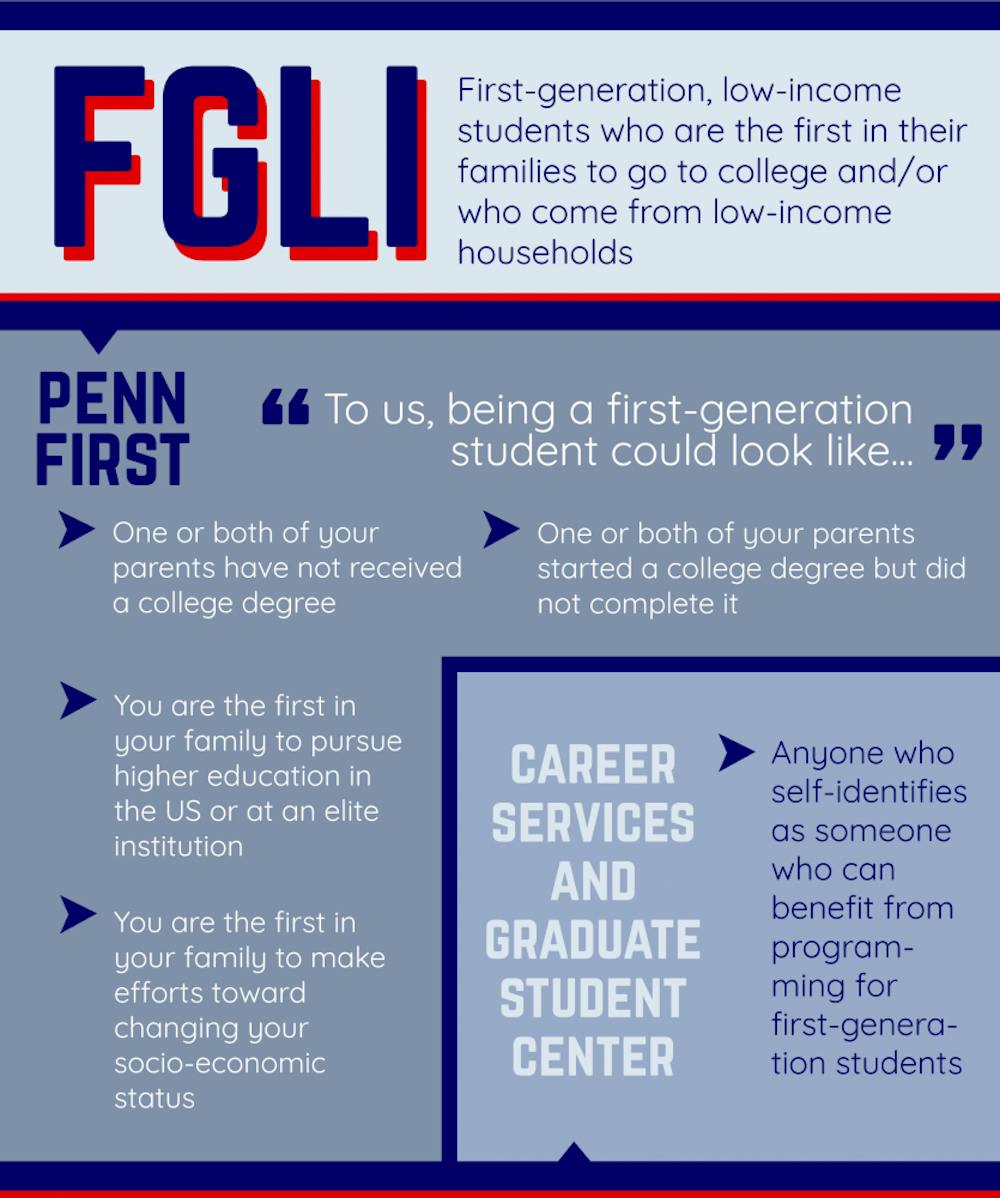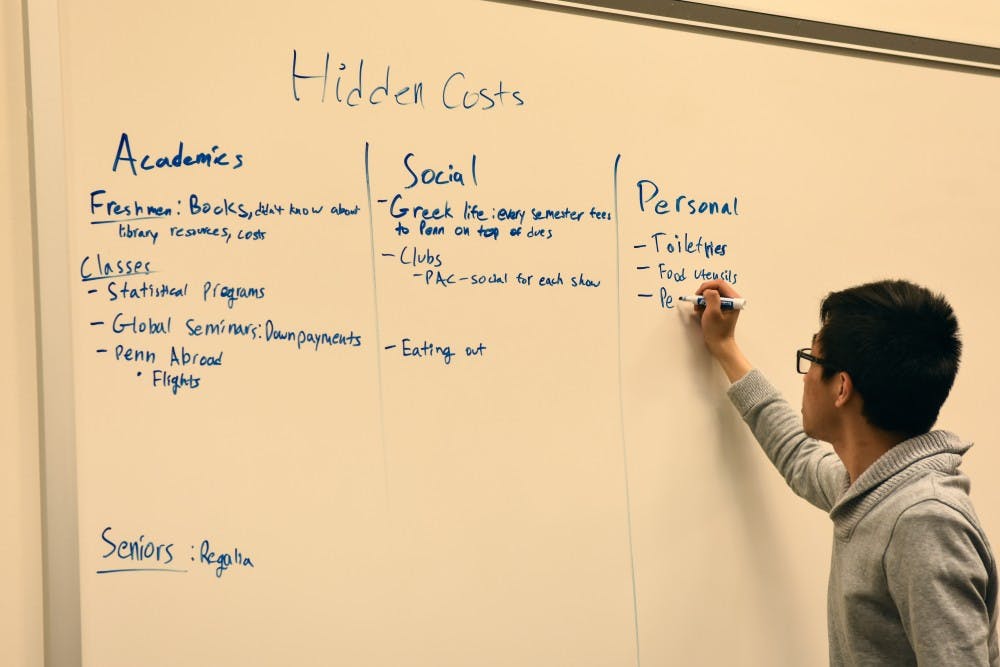
The summer before College senior Lyndsi Burcham began her freshman year at Penn, she was faced with a task familiar to all undergraduates: either to enroll in or to opt out of the Penn Student Insurance Plan.
Since Burcham did not have health insurance, she needed to enroll. She was shocked to discover, however, that she would have to pay approximately $3,000 and remembered thinking she couldn't afford the fee.
“At that time I was like, 'Oh god, how do I get that covered,' because when I was a senior in high school my parents couldn’t help me with anything,” Burcham said. “I mean, I had teachers at my high school who paid for my first plane ticket to come to Penn.”
While Burcham, the advocacy chair for Penn First — a student organization for first-generation, low-income students — said she later learned she could receive financial assistance through Student Financial Services, she noted that she thought of this unanticipated fee as an example of a hidden cost not included in Penn's estimated cost of attendance, which exceeded $70,000 for the first time this year.
The 3.8 percent increase in cost of attendance was accompanied by a 5.25 percent increase in the total financial aid budget. For the 2018-2019 academic school year, the estimated cost of attendance is $71,200 per student and the University budget for total financial aid is $237 million.

The University uses the estimated cost of attendance — which includes direct and indirect costs associated with being a Penn student, such as tuition, housing, and transportation, according to the Student Registration and Financial Services website — to determine how much financial aid a student is eligible for.
Like Burcham, many FGLI students say there are hidden costs which are not explicitly included in the estimated cost of attendance, which can act as a financial burden on members of their community, even though SFS takes steps to address these fees on an individual basis.
These hidden costs can take the form of unanticipated funds spent on classes, transportation, textbooks, social activities, and personal expenses like toiletries.
"A low-income student doesn't have walking around money," said Mark Kantrowitz, a financial aid expert and former publisher of Cappex, which is a website connecting students to colleges and scholarships. "There are a lot of costs that aren’t part of the official costs that they nevertheless have to pay that makes things difficult and so they have to make choices like do they buy some cold weather gear or do they eat a meal."
The SRFS website notes that the cost of enrollment in PSIP is added to an individual student's cost of attendance if they enroll and indicates that students can contact their financial aid counselor for additional financial aid.
Kantrowitz — who is the current publisher of savingforcollege.com, a site devoted to paying and saving for college — added that while he believes the most selective institutions could afford to eliminate tuition entirely, they choose instead to raise it repeatedly for a variety of reasons including expansion and inflation.
He posited that a possible solution to hidden costs would be to include them in the cost of attendance to make the figure more "comprehensive" and "realistic" to avoid “nickeling and diming” students. He added that he thinks these costs should be explicitly listed in the cost of attendance so that it better reflects the reality of a student's financial experience at a university.
Last spring, students at the Penn First Summit echoed Kantrowitz's sentiment as they discussed the issue of hidden costs, expressing support for the explicit inclusion of hidden fees in the total cost of attendance.They noted they thought the addition of these costs would qualify students for higher aid, since Penn uses the cost of attendance to determine a student's eligibility for financial aid.

Elaine Papas-Varas, the University director of financial aid, explained that SFS uses a number of calculations to determine each component of the total cost of attendance.
For example, she said, in order to establish the estimated costs associated with the category "Books and Supplies," the office obtains "extensive documentation" about what each school at Penn requires of its students.
She noted fees not currently included in the cost of attendance can be added on at a later time.
“There are things that we absolutely do miss," Papas-Varas said referring to fees that some students are required to pay. "We would look at those on a case-by-case [basis]."
Papas-Varas said SFS accepts appeals from students in cases when expenses for a category in the cost of attendance exceed the amount officially calculated by the office.
For example, she added, students who think they are being required to spend more on their textbooks than was originally estimated in their financial aid calculations, can provide the office with their syllabi and receipts for money spent on books. If the office finds that the students spent more than the expected amount for textbooks at their school, their individual cost of attendance can be adjusted to better reflect their experience.
Noting that the program at the Greenfield Intercultural Center helps students to identify and receive financial support for hidden costs, Burcham said she believes improvements, such as the addition of a full-time FGLI program coordinator, could be made to better aid the FGLI community.
“Our goal is that eventually there will be a much more efficient, streamlined, very transparent process for these issues to be resolved and for them to be communicated with students ahead of time,” Burcham said.
Correction: A previous version of this article stated Kantrowitz was the publisher of Cappex. This version has been updated to reflect that he is the former publisher of Cappex and the current publisher of savingforcollege.com. The DP regrets the error.
The Daily Pennsylvanian is an independent, student-run newspaper. Please consider making a donation to support the coverage that shapes the University. Your generosity ensures a future of strong journalism at Penn.
Donate







